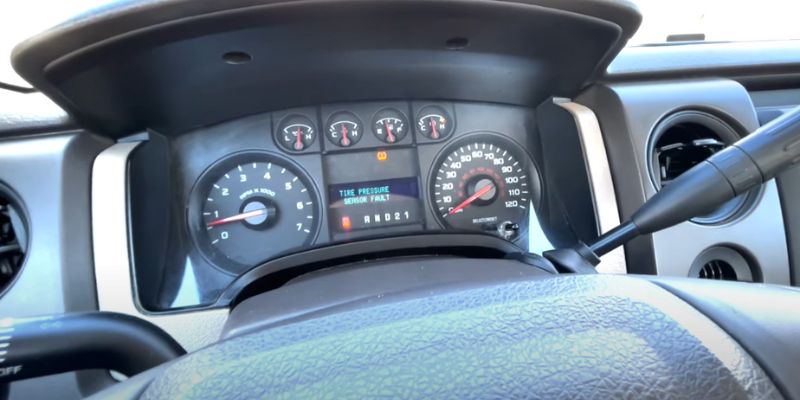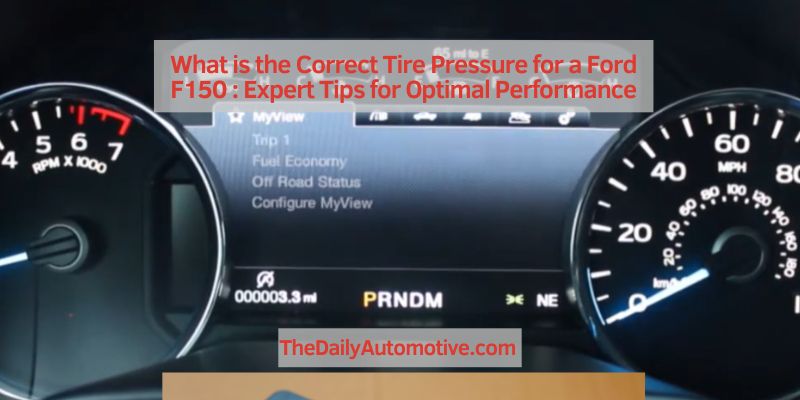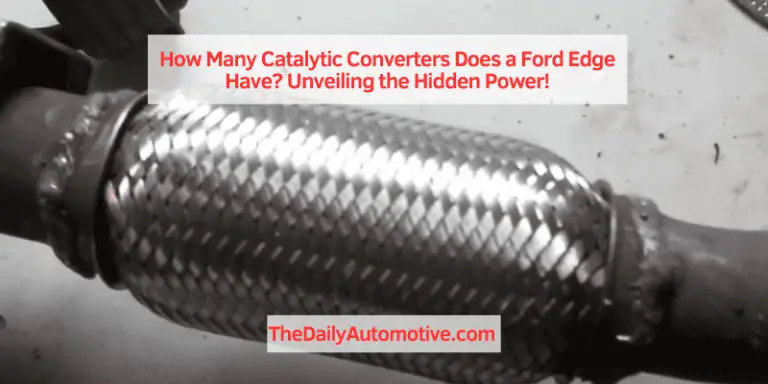What is the Correct Tire Pressure for a Ford F150 : Expert Tips for Optimal Performance
The correct tire pressure for a Ford F150 is 35 psi for all four tires. Maintaining the correct tire pressure is crucial for the safety and performance of your vehicle.
The recommended tire pressure for a Ford F150 is 35 psi for all four tires. Proper tire pressure ensures better fuel efficiency, longer tire life, improved vehicle handling, and overall safety. It’s important to check your tire pressure regularly, especially before long trips or when carrying heavy loads.
Underinflated or overinflated tires can lead to decreased gas mileage, uneven tire wear, decreased handling, and increased risk of tire blowouts. By following the manufacturer’s recommended tire pressure, you can ensure a smooth and safe driving experience with your Ford F150.
Understanding The Importance Of Correct Tire Pressure
Understanding the importance of correct tire pressure is crucial for maintaining the performance, safety, and longevity of your Ford F150. Proper tire pressure not only optimizes the vehicle’s performance but also ensures the safety of everyone on board. Additionally, maintaining the correct tire pressure can have a positive impact on fuel efficiency and the lifespan of your tires. Let’s explore how tire pressure influences these essential aspects of your vehicle.
Impact On Vehicle Performance
The correct tire pressure is crucial for maintaining optimal vehicle performance. When your tires are properly inflated, it ensures that the vehicle handles and maneuvers as intended by the manufacturer. This provides better traction, improved braking performance, and overall stability, especially when driving at high speeds or around corners. Conversely, underinflated or overinflated tires can lead to decreased performance, negatively impacting your driving experience.

Safety And Handling Considerations
Proper tire pressure plays a significant role in the safety and handling of your Ford F150. Inflating the tires to the manufacturer’s recommended pressure levels ensures that the tires maintain their shape, reducing the risk of blowouts and enhancing the vehicle’s stability during emergency maneuvers. Moreover, maintaining the correct tire pressure helps prevent uneven wear, ensuring consistent traction and handling in various road conditions, ultimately contributing to a safer driving experience.
Fuel Efficiency And Tire Longevity
Maintaining the correct tire pressure can positively impact both fuel efficiency and tire longevity. When your tires are properly inflated, it reduces the rolling resistance, resulting in improved fuel economy. Additionally, proper tire pressure helps in evenly distributing the vehicle’s weight across the tires, preventing premature wear and tear, leading to extended tire life. By adhering to the recommended tire pressure guidelines, you can maximize the efficiency of your Ford F150 while promoting the longevity of your tires.
Determining The Correct Tire Pressure For Ford F150
Proper tire pressure is essential for the performance, safety, and longevity of your Ford F150. Determining the correct tire pressure involves considering various factors such as the vehicle manual, tire pressure monitoring system (TPMS), and the impact of ambient temperature. Understanding these factors will help you maintain the optimal tire pressure for your Ford F150.
Referencing The Vehicle Manual
The vehicle manual is a valuable resource for determining the correct tire pressure for your Ford F150. It provides specific recommendations from the manufacturer based on the vehicle’s weight, tire size, and intended use. Always refer to the vehicle manual to ensure you are inflating your tires to the recommended pressure for your specific model and year.
Tire Pressure Monitoring System (tpms)
The TPMS is an integrated system in modern vehicles, including the Ford F150, that continuously monitors the air pressure in the tires. When the pressure in any tire drops below a certain level, the TPMS alerts the driver through a warning light or message on the dashboard. It is important to pay attention to the TPMS alerts and inspect the tire pressure promptly to maintain safe driving conditions.
Importance Of Ambient Temperature
The ambient temperature plays a crucial role in determining the correct tire pressure for your Ford F150. As temperatures fluctuate, so does tire pressure. Changes in temperature affect the tire pressure by approximately 1 psi for every 10-degree Fahrenheit change. It is vital to consider the impact of ambient temperature and adjust the tire pressure accordingly to ensure optimal performance and traction.
Factors Affecting Tire Pressure
Understanding the correct tire pressure for your Ford F150 is crucial for maintaining optimal safety and performance. Several factors can influence the appropriate tire pressure, including load capacity and distribution, tire type and size, as well as terrain and driving conditions. Let’s delve into each of these factors to ensure your Ford F150 is equipped with the right tire pressure for a smooth and safe ride.
Load Capacity And Distribution
The load capacity and distribution on your Ford F150 can significantly impact tire pressure. When carrying heavy loads, the tires bear more weight, requiring higher pressure to support the additional weight. Similarly, uneven distribution of cargo can lead to uneven tire wear and potential safety hazards. Be sure to refer to Ford’s recommended tire pressure guidelines based on load capacity and distribution to maintain optimal performance and safety.
Tire Type And Size
Choosing the right tire type and size is essential for maintaining the correct tire pressure. Different tire types, such as all-season, summer, or winter tires, may have varying pressure requirements. Additionally, the size of the tires, including width and aspect ratio, can impact the recommended pressure levels. Always consult your Ford F150 manual or a professional to determine the appropriate tire pressure based on your specific tire type and size.
Terrain And Driving Conditions
Terrain and driving conditions play a crucial role in determining the ideal tire pressure for your Ford F150. Driving on rough terrain or in challenging weather conditions may necessitate adjustments to the tire pressure to ensure optimal traction and performance. For instance, driving on snow-covered roads may require lower tire pressure for enhanced grip. Regularly assess the terrain and driving conditions to make informed decisions about adjusting tire pressure to accommodate varying environments.
Tips For Maintaining Optimal Tire Pressure
If you want your Ford F150 to deliver top-notch performance, maintaining the correct tire pressure is essential. Keeping your tires properly inflated not only ensures a smooth and safe ride but also extends the lifespan of your tires. Here are some helpful tips for maintaining optimal tire pressure for your Ford F150.
Regular Pressure Checks And Adjustments
Regularly checking and adjusting the tire pressure of your Ford F150 is crucial for optimal performance. Underinflated tires can lead to reduced fuel efficiency and uneven wear, while overinflated tires can cause poor handling and increase the risk of a blowout.
Use a tire pressure gauge to measure the pressure in each tire at least once a month, especially before long trips. Refer to the owner’s manual or the sticker inside the driver’s door jamb for the recommended pressure. If the pressure is too high or too low, use a quality air compressor to adjust it to the correct level.
Proper Inflation Techniques
When inflating your Ford F150’s tires, it’s important to follow the proper techniques to ensure accurate results. First, remove the valve cap and attach the tire pressure gauge to the valve stem. Add or release air as needed to achieve the recommended pressure. Be sure to replace the valve cap after each check to prevent moisture and debris from entering the valve, which could lead to leaks.
Additionally, consider using a digital or analog tire pressure gauge for more precise readings. These tools can help you achieve the correct tire pressure with greater accuracy.
Monitoring Tire Wear And Tear
In addition to regular pressure checks, it’s important to monitor the wear and tear on your Ford F150’s tires. Inspect them for irregular tread wear, bulges, or damage on a regular basis. Uneven tread wear can be a sign of underinflation or overinflation, while bulges or damage may indicate a need for tire replacement.
Furthermore, pay attention to any vibrations or unusual noises while driving, as these could be indicators of tire issues. Addressing any tire-related problems promptly can help maintain optimal tire pressure and overall vehicle safety.
Consequences Of Incorrect Tire Pressure
Incorrect tire pressure in your Ford F150 can have serious consequences on both safety and performance. It’s vital to understand the risks and effects of underinflation and overinflation, as well as how tire pressure impacts the overall performance of your vehicle.

Underinflation Risks And Effects
Underinflated tires pose numerous risks and effects, including:
- Increased rolling resistance leading to decreased fuel efficiency
- Uneven tread wear, reducing the lifespan of the tires
- Reduced handling and braking performance
- Inadequate support for the vehicle’s weight, potentially leading to overheating and blowouts
- Decreased stability and increased risk of hydroplaning in wet conditions
Overinflation Risks And Effects
On the other hand, overinflated tires also come with their own set of risks and effects, such as:
- Reduced traction due to a smaller contact patch with the road
- Uneven tread wear, reducing the lifespan of the tires
- Increased susceptibility to impact damage and punctures
- Harsher ride quality and decreased comfort
Impact On Overall Vehicle Performance
The correct tire pressure is crucial for optimizing the overall performance of your Ford F150, affecting:
- Steering and handling responsiveness
- Braking distances and control
- Fuel efficiency and environmental impact
- Ride comfort and vehicle stability
Frequently Asked Questions For What Is The Correct Tire Pressure For A Ford F150
What Is The Recommended Tire Pressure For A Ford F150?
The recommended tire pressure for a Ford F150 is typically between 30 to 35 psi. However, it’s important to consult your vehicle’s manual or the sticker on the driver’s side door jamb for the precise tire pressure specifications.
How Does Tire Pressure Affect The Performance Of A Ford F150?
Proper tire pressure is essential for the performance and safety of your Ford F150. Incorrect tire pressure can impact fuel efficiency, tire wear, and overall handling. Maintaining the recommended tire pressure helps ensure optimal driving experience and extends the life of your tires.
What Are The Consequences Of Overinflated Or Underinflated Tires On A Ford F150?
Overinflated tires can lead to decreased traction and uneven tire wear, while underinflated tires may cause poor fuel economy and increased risk of blowouts. Both scenarios can compromise the safety and performance of your Ford F150, making it crucial to maintain the correct tire pressure.
How Often Should I Check And Adjust The Tire Pressure For My Ford F150?
It’s advisable to check your Ford F150’s tire pressure at least once a month and before long trips. Adjust the pressure as needed to match the manufacturer’s specifications. Regular maintenance of tire pressure contributes to a smoother driving experience, extended tire life, and enhanced safety on the road.
Conclusion
Maintaining the correct tire pressure for your Ford F150 is crucial for safety, performance, and fuel efficiency. By regularly checking and adjusting the tire pressure according to the manufacturer’s recommendations, you can ensure optimal driving conditions and extend the lifespan of your tires.
With the right tire pressure, you can enjoy a smooth and safe ride while also reducing the risk of accidents and costly repairs.









2 Comments